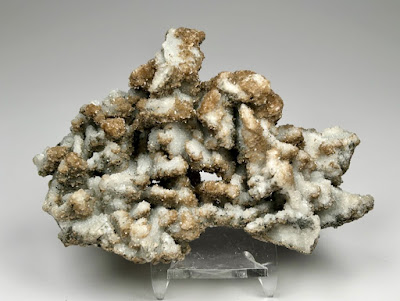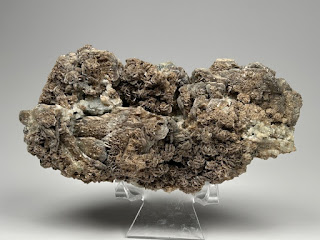ヌケガラ状の鉱石 Incrustation Pseudomorph
標本 #1
size: 12 × 8.5 × 3.5 cm / weight: 176 g
尾去沢ではしばしば「ヌケガラ状」の石英がみられた(以前紹介した別標本の記事はこちら)。重晶石の板状結晶を覆うように石英の微結晶が沈殿した後、重晶石が溶解し、その板状結晶の形だけが空洞として残ったもの(被覆仮晶)、と一般に解釈されている(「南部鉱物標本解説」原著:南部秀喜、茨城県自然博物館、1996年;木下亀城・湊秀雄「続 原色鉱石図鑑」保育社、1963年、など)。上の標本も板状の「空洞」が多数みられ、ヌケガラ石英の特徴を示す。石英をさらに覆うように薄茶色の重晶石の結晶が散りばめられ、よい景色になっている。これは相当量の鉛がバリウムを置換した含鉛重晶石 (Ba,Pb)SO4 で、尾去沢ではしばしばみられる。その他、黒っぽい鉱物も散りばめられているが、結晶形が不明瞭で、わたしのスキルでは鑑別できない。
This specimen will be a quartz epimorph (incrustation pseudomorph) after tabular barite, which is not rare in Osarizawa (see another example shown before). Brown crystals are lead-bearing barite, which is also not rare in Osarizawa. There are black minerals too, but I can't identify it.
標本 #2
size: 12.5 × 8.5 × 4.2 cm / weight: 396 g
石英、緑泥石、黄鉄鉱の細かい結晶が固着して岩片を形成していて、そこに径 5 mm から 10 mm 超の黄銅鉱の結晶が数個、付着もしくは埋め込まれている。ごく少量の透明な閃亜鉛鉱を伴う。全体がカサカサしていて、空洞がみられることから、これも何らかの「ヌケガラ」と考えられる。黄銅鉱の表面は青黒い被膜で覆われていて、結晶化後に変質作用を受けたことを示唆する。緑泥石はサイズが微小で正直なところ鉱物種の同定に自信がないが、薄板状の結晶が集合して径 0.3 mm くらいの球形をなしているのがおもしろい。
Chalcopyrite crystals of 5 to over 10 mm in size are embedded with a very small amount of transparent sphalerite in a piece of porous ore composed of minute crystals of quartz, pyrite, and chlorite. The texture implies it might be an epimorph after some material. The chalcopyrite crystal is coated by a blue-black mineral, indicating a kind of alteration process occurred after primary crystallization. Chlorite shows a globular crystal habit of sub-mm scale.
来満鉱山は1950〜60年代に探鉱・採掘された。鉱床は小規模で、そのすぐ南隣にある、江戸から明治期に大々的に稼行された不老倉鉱山の鉱脈に付随するものと考えられる。「日本の鉱床総覧 下巻」(日本鉱業協会、1968年)によると、不老倉の主な鉱石鉱物は黄鉄鉱と黄銅鉱で、鉱脈によっては閃亜鉛鉱や方鉛鉱もみられた。また脈石には石英、緑泥石、方解石、赤鉄鉱などがみられた。来満鉱山も似たようなもので、黄鉄鉱・黄銅鉱が主で、閃亜鉛鉱・方鉛鉱は少なく、脈石には石英、緑泥石、方解石と少量の絹雲母がみられた。
The ore field of the Raiman Mine, prospected and excavated in 1950s to 1960s, was a kind of small-scale satellite deposit near the Furokura Mine that produced a considerable amount of copper in the Edo to Meiji periods. According to literature, the ore minerals in the Furokura Mine were mainly pyrite and chalcopyrite, accompanying sphalerite and galena in some veins. The gangue minerals were quartz, chlorite, calcite, and hematite. The Raiman Mine was basically similar; there occurred pyrite and chalcopyrite as primary ore minerals, and quarts, chlorite, calcite, and a little sericite.
補足
-
今回のも含め、このブログで紹介または言及した「ヌケガラ」と考えられる鉱石の産地と主要構成鉱物をまとめた。いずれも秋田県内の鉱床の産物。
Summary of incrustation pseudomorphs that have been shown in this blog.
Locality Minerals composing epimorph #1 尾去沢鉱山 Osarizawa 石英+含鉛重晶石
Quartz + Lead-bearing Baryte#2 来満鉱山 Raiman 石英+黄鉄鉱+緑泥石+黒変した黄銅鉱
Quartz + Pyrite + Chlorite + Blackish Chalcopyrite#3
→ Link尾去沢鉱山 Osarizawa 石英+緑色に変質した黄銅鉱
Quartz + Greenish Chalcopyrite#4
→ Link小坂鉱山 Kosaka 石英+黒変した黄銅鉱
Quartz + Blackish Chalcopyrite#5
→ Link荒川鉱山 Arakawa 石英+黒変した黄銅鉱
Quartz + Blackish Chalcopyrite#1、#3、#5 は重晶石後の仮晶と考えられる。その他は「穴ぼこ」の形が明確でないので、そもそもヌケガラかどうか判然としない。これら鉱石には以下の共通点がある:
-
すべて母岩(晶洞の周囲の岩石)から分離した、いわゆるフローター(浮きゲス)である。
⇒ これは当然で、まず晶洞に重晶石などの結晶ができて、その上にヌケガラが形成されるので、重晶石なきあとはヌケガラは晶洞中に「浮いて」しまう。
-
黄銅鉱が付着しているものについては、いずれも表面が「変質」している。
⇒ これも偶然ではなく、秋田あたりの鉱床形成プロセスに起因する、普遍的な特徴なのではなかろうか?たとえばまず重晶石が、つぎに石英や黄銅鉱が晶出し、重晶石が溶けて、さいごに黄銅鉱を酸化させるような熱水が侵入する、とか。
These are cosidered to be epimorph after barite except for #2 and #4, of which the cavity's shape is unclear. Two characteristics can be pointed out: (1) Every piece is a floater that is separated from a surrounding rock. This is a natural consequence from the generation process where the base material growing from the host rock disappears. (2) Chalcopyrite experiences surface alteration. I guess that this is also a general characteristic originating from the generation process.
-
-
若林弥一郎は荒川鉱山のヌケガラ鉱石を詳細に記述している(「荒川鉱山付近の鉱物」地質学雑誌、10巻 121号、382〜399ページ、1903年)。まずヌケガラの元になったのは重晶石だと断定している。つぎにヌケガラ鉱石を何種類ものタイプに分類しているが、構成鉱物の観点からは
- 石英のヌケガラ
- 黄銅鉱のヌケガラ
- 石英のヌケガラの上に黄銅鉱または黄鉄鉱が結晶するもの
の3タイプに大別できる。残念ながらタイプ2、3の黄銅鉱の表面がすべて変質しているのか、黄金色に輝いているものがあるのかは記述がない。その他、
- ヌケガラ石英が複数の鉱脈で、かつさまざまな深度で、広範囲にみられること
- 重晶石の抜け跡が丸みを帯びて、曲面になったものがあることから、少なくともこの場合、重晶石の溶解と石英・黄銅鉱の沈着とがほとんど同時期に起こったことが示唆されること
は重要な指摘とおもわれる。
Wakabayashi Yaichiro gave detailed description about epimorph observed in the Arakawa Mine. The preexisting mineral was barite. There were roughly three types: quartz epimorph, chalcopyrite epimorph, and quartz epimorph with pyrite and chalcopyrite crystals. Wakabayashi didn't describe whether chalcopyrite of the second and third types generally exprienced surface alteration. He also pointed out that quartz epimorph was widely observed in various depths of various veins, and that, in some cases, leaching of barite and crystalization of quartz seemed to occur at almost the same time.
-
秋田県北鹿地方の黒鉱鉱床では一般に下から上に向かって、珪鉱 → 黄鉱 → 黒鉱 → 重晶石 → 鉄石英、のような層序がみられる。これは、熱水溶液から鉱物が沈殿するときの温度が高いほうから低いほうに順に、黄鉄鉱・黄銅鉱 → 閃亜鉛鉱・方鉛鉱 → 重晶石 → 赤鉄鉱、だったとすれば説明がつく(島崎英彦「鉱石の生い立ち」2016年)。鉱脈型の鉱床でも、このような沈殿温度に起因するとおもわれる鉱物分布がしばしばみられる。尾去沢では、典型的には鉱脈の下から上に向かって、黄鉄鉱・黄銅鉱 → 閃亜鉛鉱・方鉛鉱 → 緑泥石・赤鉄鉱、のような垂直分布がみられるし、またある深さでみたときの鉱脈の断面が、壁面から鉱脈中心に向かって同様の帯状の構造を示すことがあり、しばしば鉱脈中央に重晶石が結晶する(「日本の鉱床総覧 下巻」222〜229ページ、1968年;「南部鉱物標本解説」1996年)。
ヌケガラの元になった重晶石はいつ結晶して、いつ溶脱したのだろうか?タイミングとしてありうると(わたしのおぼつかない頭で)考えられるのは、
鉱脈のできはじめ、まだ周囲の母岩が温まっていない頃に、重晶石(や緑泥石、赤鉄鉱などの低温晶出の鉱物)のみの脈ができて、その後、下から熱い熱水が湧き上がってきて溶ける
鉱脈がじゅうぶん発達して熱水活動が終わる頃、鉱脈の中心部の流路に重晶石の結晶ができるが、なぜか再び熱い熱水が湧き上がってきて溶ける
の2パターンだろう。専門家がどう考えているのか、不勉強につきいまいちよくわからないが、一般には、ヌケガラを構成する石英の結晶が微細であることから、後者(formed at later stage)と考えられているようだ("Introduction to Japanese Minerals"、地質調査所、164ページ、1970年)。しかし鉱脈形成の最終段階でなぜ重晶石が溶けなければいけないのだろうか?出し忘れた熱水が(中高年諸氏の残尿みたいに)再度あとからやってくるのだろうか?ヌケガラ石英にともなう黄銅鉱がほとんど常に変質しているようにみえることからして、最後の最後に黄銅鉱を酸化させ、かつ重晶石を溶かすような熱水が侵入するのだろうか?
Observation shows that a typical kuroko-type deposit in the north-eastern part of Akita is comprised of layers of silicic ore, yellow ore, black ore, barite, and iron-bearing quartz, seen from the bottom to the top. This rule can be explained if the precipitation temperatures of pyrite and chalcopyrite, sphalerite and galena, barite, and hematite are in the decreasing order. In the Osarizawa Mine, which excavated hydrothermal veins, a similar order of mineral occurrence was observed along the vertical direction, and also along the cross section of a vein, where barite generally occurred at the center.
When did barite crystals occur and when did it dissolve to generate quartz epimorph? Though my understanding might be poor, it would be reasonable that (1) barite crystalized at the early stage when the host rock was still cool and dissolved due to incoming of hotter fluid from below, or (2) barite crystalized at the vein's center at the final stage of mineralization and a hotter fluid came again for some reason. It seems that experts think the latter (2) is more convincing, because quartz generally shows a texture that is characteristic of formation at the lower-temperature final stage. However, I wonder why barite had to dissolve.
-
Google 検索で "epimorph after ..." と入力してヒットしたページ数は以下の通り。ネットに記載されているということは美麗な鉱物標本である場合がほとんどなので、実際の産出頻度とはかならずしも比例しないだろう。ちなみに "epimorph after" で検索すると 13900 件ほどでてくるので、これら4種で 90 % 以上を占めるとおもわれる。
mineral that once existed pages 重晶石 barite (baryte) 1509 方解石 calcite 7600 蛍石 fluorite 2940 硬石膏 anhydrite 1120 The result of Goofle Search: "epimorph after ...". I guess the above four mineral species occupy more than 90 % of what once existed inside epimorphs.
-
尾去沢の標本 #1 の場合、重晶石が溶けて、また重晶石が結晶している。これは板状重晶石の溶脱と、その後の含鉛重晶石の沈殿とのあいだにいくばくかの時間間隔があったことを意味するが、ちょっと矛盾めいている。秋田県の玉川温泉では摂氏100度近い酸性の温泉水が絶え間なく噴き出していて、そのすぐ下流では鉛を含んだ重晶石(放射能を有する北投石で、国の特別天然記念物)が生成している。尾去沢の含鉛重晶石もおなじような低温の温泉水みたいなものから時間をかけてゆっくりと沈殿したもの、なのかもしれない。
下の写真は以前紹介した同産地の含鉛重晶石(元記事はこちら)。重晶石の板状結晶を覆うように花弁状結晶が沈着しているが、ヌケガラではなく、元の重晶石がそのまま残っている。石英はほとんどみられない。
Lead-bearing barite on barite from Osarizawa Mine, Akita (width: 110 mm, weight: 209 g).







